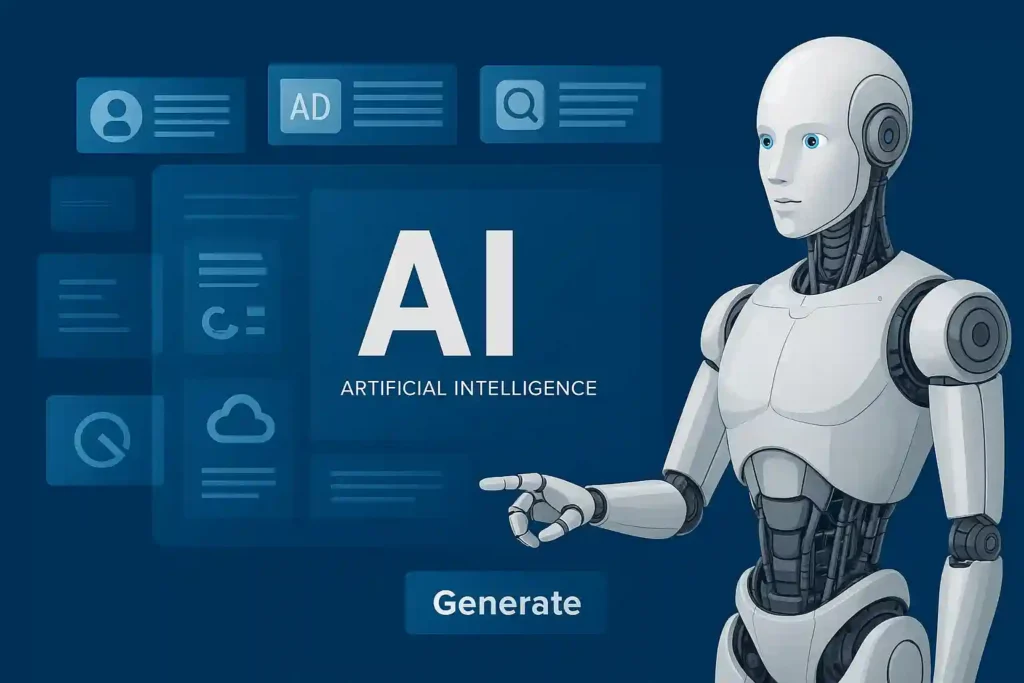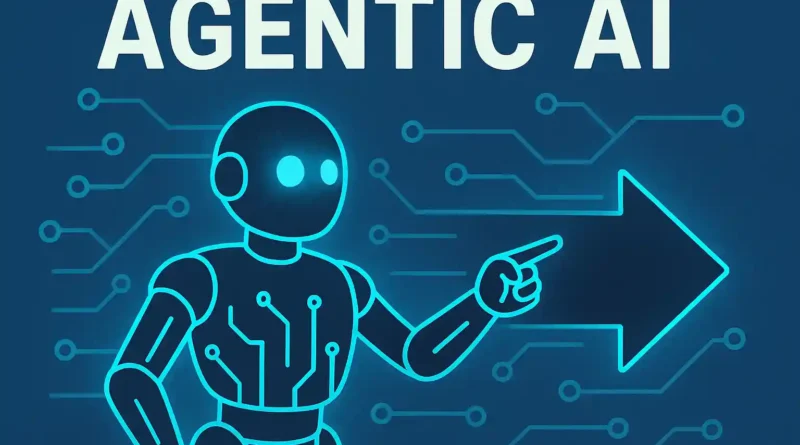Agentic AI – The Next Shift in Artificial Intelligence
Artificial Intelligence has already been shaping our daily lives in ways most of us didn’t even notice at first. From autocorrect on your phone to Netflix recommendations, AI has been quietly sitting behind the curtain, pulling strings. Then came the big wave of Generative AI. Tools like ChatGPT, MidJourney, Bard, and many others made headlines. Everyone suddenly wanted to play with prompts, create poems, generate code, or ask weird philosophical questions to a chatbot.
But, as with everything in tech, there’s always a “what’s next?” question. And the answer that’s been echoing in research labs, startups, and tech communities is something called Agentic AI.
Now, before you roll your eyes at another fancy buzzword, let’s slow down and unpack this in a simple way.
What is Agentic AI?
Think of AI up until now like a super smart assistant who waits for you to give instructions. You say, “Hey, write me an email,” and it writes one. You ask, “Make me a playlist,” and it does. This is what we mostly call Generative AI — it generates things when you ask.
Agentic AI, on the other hand, is like an assistant who doesn’t just wait around. It understands your goals, plans steps on its own, takes action, and even circles back if something goes wrong.
Instead of just producing a piece of content or answering a single query, Agentic AI can act like an agent. It has autonomy — the ability to plan, decide, and do stuff without you micromanaging every step.

Agentic AI
An easy comparison:
- Generative AI: You tell it what to do, it gives you an output.
- Agentic AI: You tell it what you want achieved, and it figures out how to get there, sometimes by chaining multiple actions or talking to other systems.
It’s a subtle but powerful shift
A Simple Example
Imagine you’re planning a trip. With Generative AI, you’d ask for “a 5-day travel plan for Manali” and it spits out an itinerary. Cool, but still just text on a page.
See the difference? It’s no longer just answering but actually acting.
With Agentic AI, you’d say “I want to plan a trip to Manali within a budget of ₹30,000.” The AI wouldn’t just give you suggestions. It could:
- Search flights and compare fares.
- Check hotels that match your budget.
- Look at weather predictions for those dates.
- Even book the tickets and hotel for you if you allow.
- And then update you later, “Hey, there’s a snowfall warning, should I rebook your travel dates?”
See the difference? It’s no longer just answering but actually acting.
Why is Everyone Talking About It?
One reason is obvious: productivity. Humans love shortcuts. If an AI can not only answer but actually handle tasks on our behalf, that’s a game changer.
But there’s another reason: we’re hitting a limit with prompt-based Generative AI. Yes, it’s fun to create art or draft emails, but businesses need more than fun. They want systems that can operate almost like employees — handling customer queries, managing inventories, doing follow-ups, fixing errors in real time.
That’s where agentic systems shine.
The Building Blocks of Agentic AI
This isn’t magic. To act as an “agent,” AI needs certain abilities that earlier models didn’t fully have. A few of them are:
- Autonomy – It doesn’t wait for constant human prompts.
- Memory – It remembers context and past interactions (not just the last sentence).
- Reasoning – It can weigh options, plan steps, and troubleshoot when things don’t work.
- Tool Use – It connects with apps, APIs, and systems outside itself.
- Feedback Loops – It learns from results and adjusts next actions.
Put these together and you have something that’s more than a chatbot. You get a digital “agent” that operates almost like a human intern, or sometimes better.
Where Can Agentic AI Be Used?
This is where things get exciting (and a little scary). Let’s run through some scenarios.
1. Customer Support
Instead of replying with copy-paste answers, an agentic AI could actually check your order status, raise a ticket, or issue a refund — automatically.
2. Healthcare
Imagine booking a doctor appointment. Instead of juggling apps, you’d just tell the AI, “I need an appointment for next week,” and it would handle the entire scheduling. It might even pull your reports from the lab, summarize them, and send to your doctor.
3. Finance
You could tell it, “Manage my monthly expenses within ₹50,000.” It would track your spending, pay bills on time, and alert you before you overspend.
4. Education
Rather than just giving answers, agentic AI could design a personal study plan, quiz you regularly, and adjust lessons based on how fast or slow you’re learning.
5. Business Automation
Think of HR tasks, inventory checks, email follow-ups — all those repetitive things could be handled by AI agents.
Benefits – Why This Matters
- Saves Time: Less micromanagement.
- Reduces Errors: Machines don’t forget deadlines.
- Scales Easily: One AI agent can handle thousands of customers simultaneously.
- 24/7 Workhorse: No coffee breaks, no vacations.
The Flip Side – Risks and Concerns
Of course, this isn’t all rainbows and unicorns. With autonomy comes responsibility, and that’s where the red flags are.
- Trust Issues: Do we trust AI to make the right call without oversight?
- Security: What if a malicious actor tricks the AI into making harmful decisions?
- Bias and Fairness: If the AI’s data is flawed, its decisions will be flawed too.
- Job Displacement: Some routine roles could get replaced.
- Control: What if an agent starts chaining actions in ways we didn’t intend?
So, while this is exciting, it’s also something that needs careful guardrails.
Agentic AI vs Generative AI – A Quick Recap
To make it crystal clear:
- Generative AI = creates outputs (text, image, code).
- Agentic AI = plans and executes tasks, often using Generative AI as one of its tools.
In a way, you can think of agentic AI as the “manager” and generative AI as the “worker.”
The Future Ahead
We’re at an early stage. Don’t expect your phone to suddenly run your entire life tomorrow. But the direction is clear: AI is moving from passive responder to active doer.
Companies are already building platforms for multi-agent collaboration, where different AI agents talk to each other to solve problems. Imagine one agent specializing in finance, another in travel, another in medical data — and all of them working together seamlessly.
Some experts believe this could eventually lead to Artificial General Intelligence (AGI), where machines can perform almost any intellectual task a human can. That’s the dream… or the nightmare, depending on your perspective.
My Take
Personally, I think Agentic AI is going to become part of everyday life sooner than most people expect. At first, it’ll slip into small things — like smarter scheduling, shopping, or customer support. But gradually, it might handle bigger life decisions, like financial planning or health monitoring.
The question isn’t if this happens, but how responsibly we guide it. Will companies prioritize ethics, security, and transparency? Or will the race for profit push AI into messy territories? Only time will tell.
What I know for sure is that ignoring it is not an option. Agentic AI is coming, whether we’re ready or not.
Final Thoughts
To wrap this up — Agentic AI is not just another buzzword. It’s a step change. It takes AI from being reactive to proactive. From tool to teammate. From “answering” to “acting.”
We’re still in the early innings, but the wave has already started. If Generative AI was the spark that caught the world’s attention, Agentic AI might be the fire that transforms industries.
And as with every fire, it can either warm us or burn us. The choice is in how we build, regulate, and adopt it.
Q1. Is ChatGPT an Agentic AI?
ChatGPT itself is not a fully agentic AI. It is primarily a generative AI model — it responds to prompts by generating text. However, when ChatGPT is connected with external tools, memory, or plugins (for example, browsing, coding, or automation systems), it can show agentic behavior by planning and taking actions beyond just generating text.
Q2. What is the difference between Generative AI and Agentic AI?
Generative AI focuses on creating content like text, images, or code based on prompts.
Agentic AI goes a step further — it can plan, make decisions, and execute tasks without constant human instructions. Think of Generative AI as a creator and Agentic AI as a problem-solver and doer.
Q3. What are the 4 types of AI?
Artificial Intelligence is usually divided into four categories:
Reactive Machines – Basic AI that only reacts to situations (e.g., chess-playing programs).
Limited Memory – AI that learns from past data but has limited recall (e.g., self-driving cars).
Theory of Mind – AI that can understand human emotions and intentions (still in development).
Self-Aware AI – AI that has its own consciousness (purely theoretical as of now).
Q4. Agentic AI Book
Currently, there is no single “official” book titled Agentic AI widely recognized, but researchers and authors are beginning to write papers and books on the concept. You can find resources in AI research journals and technology blogs. In the coming years, expect detailed books on how agentic AI systems are built and used.
Q5. Agentic AI vs Generative AI
Generative AI = Creates (text, image, audio, etc.).
Agentic AI = Acts (plans, decides, and executes tasks).
They are not rivals but complementary. In fact, Agentic AI often uses Generative AI as one of its tools.
Q6. Agentic AI Google
Google is also working on agentic AI systems. Its AI models like Gemini are being enhanced with planning and reasoning capabilities, moving toward agentic features that can perform tasks rather than just generate responses.
Q7. Agentic AI Tools
Some emerging tools and platforms showing agentic AI behavior include:
AutoGPT
BabyAGI
LangChain (framework for building agentic apps)
OpenAI’s ChatGPT with plugins
ServiceNow Agentic AI tools
Q8. Agentic AI Examples
An AI that books your flight, hotel, and cab after understanding your budget.
A customer support bot that not only answers but also issues refunds.
A personal finance AI that pays your bills automatically.
AI assistants that can handle multi-step business workflows.
Q9. Agentic AI – ServiceNow
ServiceNow has announced integration of Agentic AI in its workflows. The idea is to let AI not only answer employee/customer queries but also act on them — like resolving tickets, managing tasks, and automating backend processes.
Q10. Agentic AI OpenAI
OpenAI is experimenting with agentic behavior in its models. For example, ChatGPT with memory, browsing, and code execution is a step toward agentic AI. OpenAI has also mentioned research into autonomous agents that can plan and perform multi-step actions.
Q11. Agentic AI Microsoft
Microsoft, in partnership with OpenAI, is embedding agentic AI capabilities into Copilot for Office, Azure, and GitHub. This allows AI not only to generate documents or code but also to automate repetitive workflows, handle tasks, and act as a proactive digital assistant.
Also Read……
- Redmi 15 5G India Launch Teaser Full Specs Leak
- Vivo V60: A Game-Changing Mid-Range Smartphone in 2025
You Can also Visit Sarkari Results For Job related Query. you can follow us on Google news. Share our post. We will be thankful to all of you.

